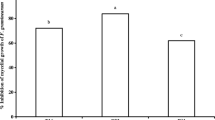Abstract
More than 600Fusarium strains were screened for their ability to produce moniliformin in vitro. They represented 90 species and 15 sections (without sectionPseudomicrocera). A simple TLC-method (agar plug method) was tested for its applicability to detect moniliformin in fungal cultures. It revealed moniliformin production in 146 strains representing 32 species, all belonging to sections of which the teleomorph is known to beGibberella. The results by and large agree with earlier published data. However, some species did not show any moniliformin production in contrast to other reports. Furthermore, moniliformin production is reported for the first time in two known and in two not yet described species. 58 species were unable to generate the toxin. The results support the importance to include mycotoxin production of fungi as a criterion in a polyphasic taxonomy.
Similar content being viewed by others
References
Cole RJ, Kirksey JW, Cutler HG, Doupnik BL, Peckham JC (1973) Toxin fromF. moniliforme: effects on plants and animals. Science 179: 1324–1326
Scott PM, Abbas HK, Mirocha CJ, Lawrence GA, Weber D (1987) Formation of moniliformin byFusarium sporotrichioides andFusarium culmorum. Appl Environ Microbiol 53: 196–197
Chelkowski J, Zawadzki M, Zaikowski P, Logrieco A, Bottalico A, (1990) Moniliformin production byFusarium species. Mycotoxin Res 6: 41–45
Marasas WFO, Thiel PG, Sydenham EW, Rabie CJ, Lübben A, Nelson PE (1991) Toxicity and moniliformin production by four recently described species ofFusarium and two uncertain taxa. Mycopathologia 113: 191–197
Cole RJ, Cox RH (1981) Handbook of toxic fungal metabolites: S. 894–897. Academic Press Inc., New York
Abbas HK, Mirocha CJ, Gunther R (1991) Production of zearalenone, nivalenol, moniliformin, and wortmannin from toxigenic cultures ofFusarium obtained from pasture soil samples collected in New Zealand. Mycotoxin Res 7: 53–60
Filtenborg O, Frisvad JC, Svendsen JA (1983) Simple screening method for molds producing mycotoxins in pure cultures. Appl Environ Microbiol 45: 581–585ba]
Nirenberg HI (1976) Untersuchungen über die morphologische und biologische Differenzierung in der Fusarium-Sektion Liseola. Mitt Biol Bundesanst Land- Forstwirtsch, Berlin-Dahlem 169
Scott PM, Lawrence GA (1987) Liquid chromatographic determination and stability of theFusarium mycotoxin moniliformin in cereal grains. J Assoc Off Anal Chem 70: 850–853
Kriek NPJ, Marasas WFO, Steyn PS, van Rensburg SJ, Steyn M (1977) Toxicity of a moniliformin-producing strain ofFusarium moniliforme van subglutinans isolated from maize. Food Cosmet Toxicol 15: 579–587
Marasas WFO, Leistner L, Hofmann G, Eckhardt C (1979) Occurence of toxigenic strains ofFusarium in maize and barley in Germany. Europ J Appl Microbiol Biotechnol 7: 289–305
Rabie CJ, Marasas WFO, Thiel PG, Lübben A, Vleggaar R (1982) Moniliformin production and toxicity of differentFusarium species from southern Africa. Applbiol 43: 517–521
Marasas WFO, Thiel PG, Rabie CJ (1986) Moniliformin production inFusarium sectionLiseola. Mycologia 78: 242–247
Schütt F, Nirenberg HI, Deml G (1998) Moniliformin production within theLiseola- Dlaminia complex. Accepted for publication by Cer Res Communic
Nirenberg HI and Aoki T (1997)Fusarium nisikadoi, a new species from Japan. Mycoscience 38: 329–333
Nirenberg HI, O’Donnell K, Kroschel J, Adrianaivo AP, Frank JM, Mubatanhema W (1998) Two new species ofFusarium: Fusarium brevicatenulatum from the noxious weedStriga asiatica in Madagascar andFusarium pseudoanthophilum from Zeamays in Zimbabwe. Mycologia 90: 459–464
Nirenberg HI and O’Donnell K (1998) NewFusarium species and combinations within theGibberella fujikuroi species complex. Mycologia 90: 434–458
Logrieco A, Bottalico A, Ricci V (1990) Occurence ofFusarium species and their mycotoxins in cereal grains from some Mediterranean countries. Phytopath Medit 29: 81–89
Hussein H, Baxter M, Andrew IG, Franich RA (1991) Mycotoxin production byFusarium species isolated from New Zealand maize fields. Mycopathologia 113: 35–40
Rabie CJ, Luebben A, Louw AI, Rathbone EB, Steyn PS, Vleggaar R (1978) Moniliformin, a mycotoxin fromFusarium fusarioides. J Agrie Fd Chem 26: 375- 379
Bottalico A, Visconti A, Solfrizzo M (1982) Production of moniliformin byFusarium species in Italy. Phytopath Medit 21: 105–106
Booth C (1971) The genusFusarium. CMI, Kew
Gerlach W and Nirenberg HI (1982) The genusFusarium - a pictoral atlas. Mitt Biol Bundesanst Land-Forstwirtsch, Berlin-Dahlem 209: 1–406
Nelson PE, Toussoun TA, Marasas WFO ({dy1983})Fusarium species. An illustrated manual for identification. Pa. St. Univ. Press
Burgess LW, Lidell CM, Summerell BA ({dy1988}) Laboratory Manual forFusarium Research. Univ. of Sydney
Nirenberg HI (1989) Identification of fusaria occuring in Europe on cereals and potatoes. In: Chelkowski J (Ed)Fusarium: Mycotoxins, Taxonomy and Pathogenicity. Elsvier Science Publishers BV, Amsterdam: 179–193
Nirenberg HI (1990) Recent advances in the taxonomy ofFusarium. Studies in Mycology 32: 91–101
Sharman M, Gilbert J, Chelkowski J (1991) A survey of the occurence of the mycotoxin moniliformin in cereal samples from sources worldwide. Fd Add Contam 8: 459–466
Adler A, Lew H, Brodacz W, Edinger W, Oberforster M (1995) Occurence of moniliformin, desoxynivalenol, and zearalenone in durum wheat (Triticum durum Desf.). Mycotoxin Res 11: 9–15
Author information
Authors and Affiliations
Rights and permissions
About this article
Cite this article
Schütt, F., Nirenberg, H.I. & Demi, G. Moniliformin production in the genusFusarium . Mycotox Res 14, 35–40 (1998). https://doi.org/10.1007/BF02945091
Received:
Accepted:
Issue Date:
DOI: https://doi.org/10.1007/BF02945091




